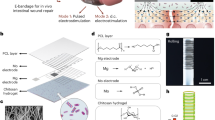Abstract
Liposomal gene transfer is an effective therapeutic approach to improve dermal and epidermal regeneration. The purpose of the present study was to define whether the biological or chemical structure of a liposome influences cellular and biological regeneration in the skin, and to determine by which mechanisms possible changes occur. Rats were inflicted a full-excision acute wound and divided into three groups to receive weekly subcutaneous injections of DMRIE liposomes plus the Lac Z gene, or DOTAP/Chol liposomes plus the Lac Z gene, or saline. Planimetry, immunological assays, histological and immunohistochemical techniques were used to determine cellular responses after gene transfer, protein expression, dermal and epidermal regeneration. DOTAP/Chol increased IGF-I and KGF protein concentration and caused concomitant cellular responses, for example, by increasing IGFBP-3, P<0.05. DOTAP/Chol liposomes improved epidermal regeneration by exhibiting the most rapid area and linear wound re-epithelization compared to DMRIE or control, P<0.001. DOTAP/Chol and DMRIE exerted promitogenic and antiapoptotic effects on basal keratinocytes, P<0.05. Dermal regeneration was improved in DOTAP/Chol-treated animals by an increased collagen deposition and morphology, P<0.001. DOTAP/Chol liposomes increased vascular endothelial growth factor concentrations and thus neovascularization when compared with DMRIE and saline, P<0.001. In the present study, we showed that different liposomes have different effects on intracellular and biological responses based on its chemical and molecular structure. For gene transfer in acute wounds, the administration of DOTAP/Chol liposomes appears to be beneficial.
This is a preview of subscription content, access via your institution
Access options
Subscribe to this journal
Receive 12 print issues and online access
$259.00 per year
only $21.58 per issue
Buy this article
- Purchase on Springer Link
- Instant access to full article PDF
Prices may be subject to local taxes which are calculated during checkout




Similar content being viewed by others
References
Cutroneo KR . Gene therapy for tissue regeneration. J Cell Biochem 2003; 88: 418–425.
Felgner PL . Nonviral strategies for gene therapy. Sci Am 1997; 276: 102–106.
Vogel JC . Nonviral skin gene therapy. Hum Gene Ther 2000; 11: 2253–2259.
Alexander MY, Akhurst RJ . Liposome-medicated gene transfer and expression via the skin. Hum Mol Genet 1995; 4: 2279–2285.
Jeschke MG et al. Biodistribution and feasibility of non-viral IGF-I gene transfers in thermally injured skin. Lab Invest 2000; 80: 151–158.
Jeschke MG, Klein D . Liposomal gene transfer of multiple genes is more effective than gene transfer of a single gene. Gene Therapy 2004; 11: 847–855.
Sun L et al. Transfection with aFGF cDNA improves wound healing. J Invest Dermatol 1997; 108: 313–318.
Singer AJ, Clark RA . Cutaneous wound healing. N Engl J Med 1999; 341: 738–746.
Scharffetter-Kochanek K, Klein P, Krieg T . Cellular and molecular mechanisms of tissue repair. Basic Res Cardiol 1998; 93 (Suppl 3): 1–3.
Jeschke MG et al. IGF-I gene transfer in thermally injured rats. Gene Therapy 1999; 6: 1015–1020.
Lee KD, Oh YK, Portnoy DA, Swanson JA . Delivery of macromolecules into cytosol using liposomes containing hemolysin from Listeria monocytogenes. J Biol Chem 1996; 271: 7249–7252.
Mahato RI et al. Biodistribution and gene expression of lipid/plasmid complexes after systemic administration. Hum Gene Ther 1998; 9: 2083–2099.
Jeschke MG, Schubert T, Klein D . Exogenous liposomal IGF-I cDNA gene transfer leads to endogenous cellular and physiological responses in an acute wound. Am J Physiol Regul Integr Comp Physiol 2004; 286: R958–R966.
Tao Z et al. Insulin-like growth factor-I cDNA gene transfer in vitro and in vivo. Biochem Genet 2000; 38: 41–55.
Hengge UR et al. Cytokine gene expression in epidermis with biological effects following injection of naked DNA. Nat Genet 1995; 10: 161–166.
Hengge UR, Walker PS, Vogel JC . Expression of naked DNA in human, pig, and mouse skin. J Clin Invest 1996; 97: 2911–2916.
Jeschke MG et al. Possibilities of non-viral gene transfer to improve cutaneous wound healing. Curr Gene Ther 2001; 1: 267–278.
Jeschke MG et al. Non-viral liposomal keratinocyte growth factor (KGF) cDNA gene transfer improves dermal and epidermal regeneration through stimulation of epithelial and mesenchymal factors. Gene Therapy 2002; 9: 1065–1074.
Caracciolo G, Pozzi D, Caminiti R, Congiu Castellano A . Structural characterization of a new lipid/DNA complex showing a selective transfection efficiency in ovarian cancer cells. Eur Phys J E Soft Matter 2003; 10: 331–336.
Ito I et al. Increased uptake of liposomal–DNA complexes by lung metastases following intravenous administration. Mol Ther 2003; 7: 409–418.
Brigham PA, McLoughlin E . Burn incidence and medical care use in the United States: estimates, trends, and data sources. J Burn Care Rehabil 1996; 17: 95–107.
Wlaschek M et al. Protease inhibitors protect growth factor activity in chronic wounds. Br J Dermatol 1997; 137: 646.
Tonnesen MG, Feng X, Clark RA . Angiogenesis in wound healing. J Investig Dermatol Symp Proc 2000; 5: 40–46.
Ferrara N . Vascular endothelial growth factor and the regulation of angiogenesis. Recent Prog Horm Res 2000; 55: 15–35; discussion-6.
Swift ME, Kleinman HK, DiPietro LA . Impaired wound repair and delayed angiogenesis in aged mice. Lab Invest 1999; 79: 1479–1487.
Tracey KJ et al. Shock and tissue injury induced by recombinant human cachectin. Science 1986; 234: 470–474.
Zhang Y, Anchordoquy TJ . The role of lipid charge density in the serum stability of cationic lipid/DNA complexes. Biochim Biophys Acta 2004; 1663: 143–157.
Boeck P . Romeis Mikroskopische Technik. München-Wien-Baltimoire: Urban u. Schwarzenberg Verlag, 1989.
Acknowledgements
This study was supported by the Deutsche Forschungsgemeinschaft (DFG Je 233/2-2), Clayton Foundation for Research and Munic Biotech AG. We had no financial interest in the study.
Author information
Authors and Affiliations
Rights and permissions
About this article
Cite this article
Jeschke, M., Sandmann, G., Finnerty, C. et al. The structure and composition of liposomes can affect skin regeneration, morphology and growth factor expression in acute wounds. Gene Ther 12, 1718–1724 (2005). https://doi.org/10.1038/sj.gt.3302582
Received:
Accepted:
Published:
Issue Date:
DOI: https://doi.org/10.1038/sj.gt.3302582



